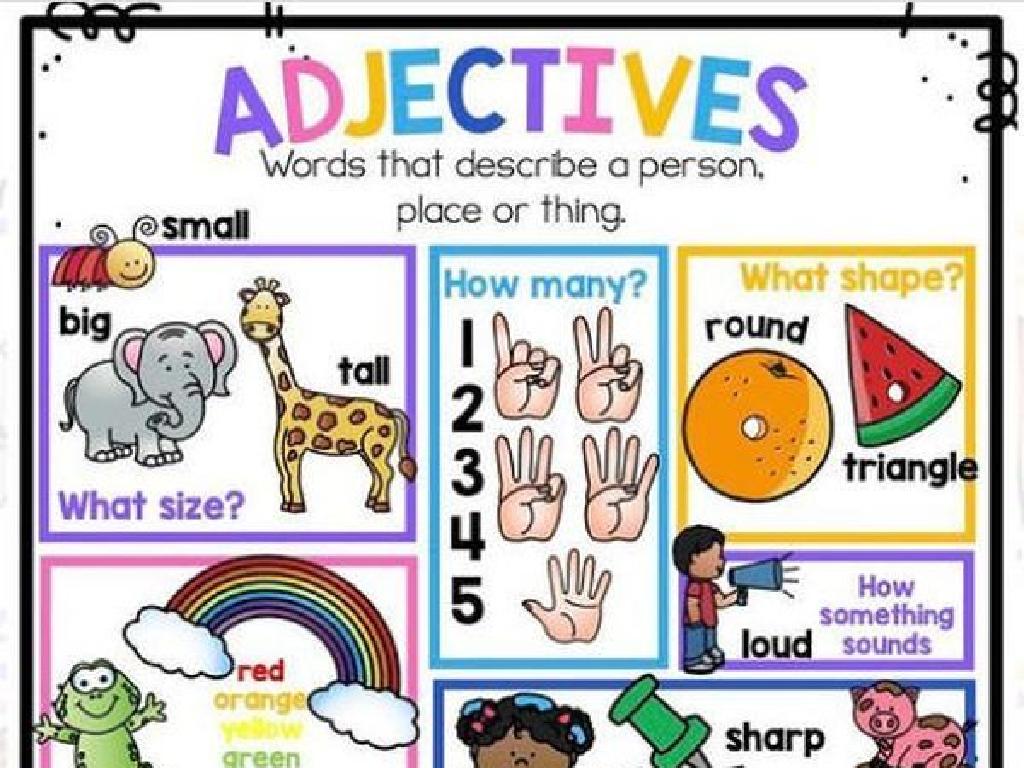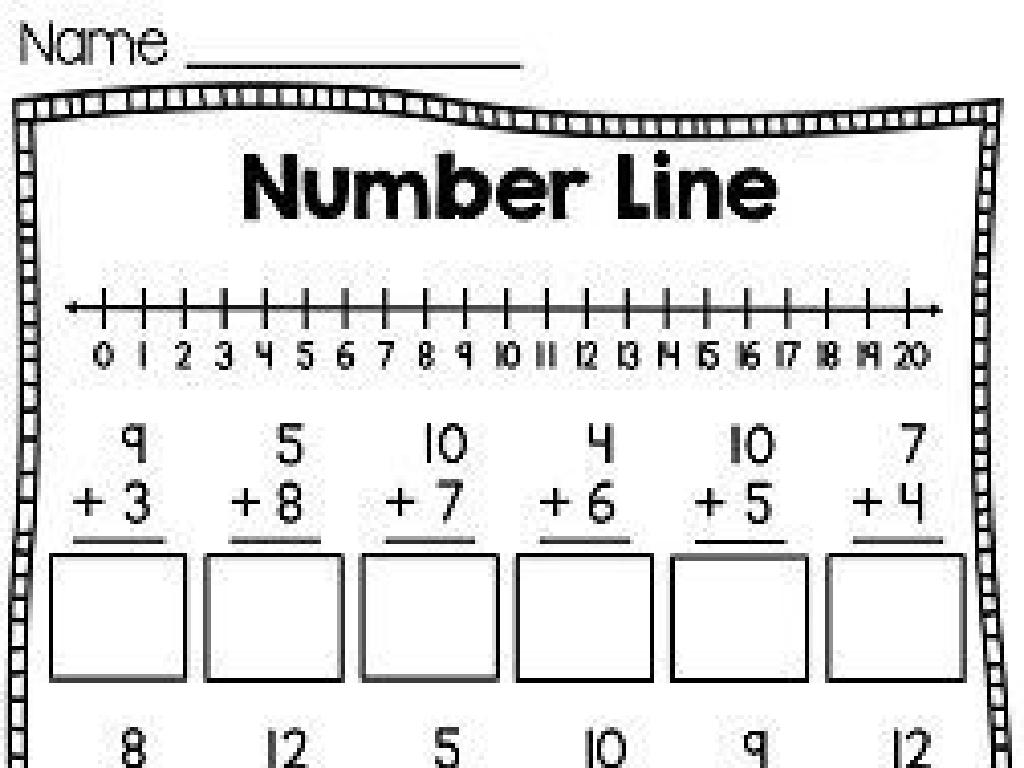Abbreviate Time And Length Units
Subject: Science
Grade: Second grade
Topic: Units And Measurement
Please LOG IN to download the presentation. Access is available to registered users only.
View More Content
Introduction to Units and Measurement
– What are units of measurement?
– Reasons we measure things
– To know how long, heavy, or warm something is
– Various units for measuring
– Inches & feet for length, pounds for weight, seconds for time
– Examples: inch, foot, second
– An inch is like the width of a thumb, a foot is twelve inches, a second is one tick of a clock
|
This slide introduces the concept of measurement to second graders, explaining that units are like the language we use to describe how big, heavy, or quick something is. Emphasize that measuring helps us in everyday life, like knowing if a shoe fits or how much time we have to play. Explain that different measurements use different units, such as inches and feet for length, and seconds for time. Use relatable examples to help them visualize the units, such as comparing an inch to the width of a thumb, a foot to a ruler, and a second to one tick of a clock. Encourage students to think of times they have used measurements in their daily lives.
Understanding Time and Clocks
– What is time?
– Time helps us know ‘when’ events happen
– Clocks: Our time-keeping tools
– Clocks show us time with numbers and hands
– Seconds, minutes, and hours
– Short times are seconds, longer are minutes, even longer are hours
– Abbreviating time units
– We write seconds as ‘sec’, minutes as ‘min’, and hours as ‘hr’
|
This slide introduces the concept of time to second graders. Begin by explaining that time is a way to measure when things happen, like when to go to school or when it’s lunchtime. Show different types of clocks and explain how they help us know the time. Discuss the units of time such as seconds, minutes, and hours, and how they are used to measure short and long durations. Teach the children how to abbreviate these units and use them in daily life. For example, 60 seconds make a minute (60 sec = 1 min), and 60 minutes make an hour (60 min = 1 hr). Use a classroom clock to demonstrate how the hands move to count time.
Abbreviating Time Units
– Hour becomes ‘hr’
– Minute becomes ‘min’
– Second becomes ‘sec’
– Practice time conversions
– Remember: 1 hr = 60 min, 1 min = 60 sec
|
This slide introduces students to the abbreviations for time units, which are shorter ways to write the words for hour, minute, and second. It’s important for students to recognize and be able to use these abbreviations when measuring time and doing related exercises. The practice examples show how to convert hours into minutes and minutes into seconds, which is a fundamental skill in understanding time. During the lesson, engage the students with practice questions, such as asking how many minutes are in 2 hours or how many seconds are in 5 minutes, to reinforce their learning.
Learning About Length
– Understanding Length
– Length measures ‘how long’ or ‘how far’ something is.
– Tools to Measure Length
– We use rulers and tapes to find out length.
– Units: Inches, Feet, Yards
– Smaller objects are measured in inches, bigger ones in feet or yards.
– Practice Measuring
– Let’s use rulers to measure things in the classroom!
|
This slide introduces the concept of length as a measurable dimension that indicates ‘how long’ or ‘how far’ an object or distance is. Emphasize the practicality of measuring length in everyday life and familiarize students with the common units of measurement such as inches, feet, and yards. Show them how to use rulers and measuring tapes, and explain that different units are used based on the size of the object or distance being measured. Incorporate hands-on activities where students can practice measuring items in the classroom to reinforce the concept.
Abbreviating Length Units
– Inch as ‘in’
– Foot as ‘ft’
– Yard as ‘yd’
– Practice conversions
– 1 ft equals 12 in, 1 yd equals 3 ft
|
This slide introduces students to the abbreviations for common length units used in the United States. An inch is abbreviated as ‘in’, a foot is abbreviated as ‘ft’, and a yard is abbreviated as ‘yd’. Understanding these basic units of measurement and their abbreviations is crucial for young learners as they encounter them in various aspects of life and study. The practice examples provided will help solidify their understanding of how these units relate to each other. Encourage students to measure objects around the classroom using a ruler or a yardstick to see these units in action. For homework, they could measure items at home and record their lengths in inches, feet, and yards.
Abbreviating Time and Length
– Writing and reading abbreviations
– Example: 3 feet 2 inches
– 3 ft 2 in is shorter than saying 3 feet 2 inches
– Example: 2 hours 15 minutes
– 2 hr 15 min saves time and space on paper
|
This slide introduces students to the concept of abbreviating units of time and length, which is a way to write them in a shorter form. It’s important to explain that abbreviations help us write more quickly and take up less space. Show how ‘feet’ can be written as ‘ft’ and ‘inches’ as ‘in’, using the example ‘3 feet 2 inches’ becomes ‘3 ft 2 in’. Similarly, demonstrate that ‘hours’ and ‘minutes’ can be abbreviated to ‘hr’ and ‘min’ with the example ‘2 hours 15 minutes’ becomes ‘2 hr 15 min’. Encourage students to practice by writing other examples of time and length using abbreviations.
Class Activity: Measure and Abbreviate!
– Measure classroom items
– Use rulers for inches and feet
– in for inches, ft for feet
– Record time with clocks
– hr for hours, min for minutes
– Abbreviate measurements
|
This interactive activity is designed to help second graders understand and practice measuring lengths using rulers and time using clocks. Provide rulers to the students and assist them in measuring various objects around the classroom, such as desks, books, and more. Then, have them use clocks to record times of certain activities, like reading or cleanup time. Encourage them to write down their measurements using the correct abbreviations: inches (in), feet (ft), hours (hr), and minutes (min). This will help them become familiar with standard units of measurement and their abbreviations. For the activity, consider pairing students up, providing a variety of items to measure, and rotating them between stations for timekeeping and length measurement. This hands-on experience reinforces their learning and makes it enjoyable.
Time & Length Abbreviations Review
– Quick quiz on time abbreviations
– Test your knowledge of time units like hr for hour, min for minute
– Partner practice: say measurements
– With a buddy, practice saying ‘3 ft’ as ‘3 feet’ or ’60 sec’ as ’60 seconds’
– Bring a watch & ruler next class
– We’ll use these tools to learn measuring time & length
– Why abbreviations are handy
|
This slide is aimed at reviewing and reinforcing the abbreviations for units of time and length. Start with a fun quiz to assess the students’ current understanding of abbreviations such as ‘hr’ for hour or ‘in’ for inch. Then, have the students pair up and practice saying measurements out loud to reinforce their learning. Remind them to bring a watch and a ruler for the next class, where they will apply their knowledge in practical activities. Emphasize the importance of abbreviations in making communication quicker and more efficient, especially in science and math.






